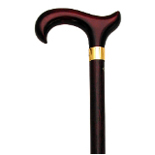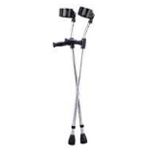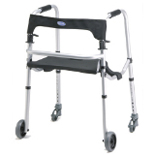Choosing the Right One

Perhaps you've injured your foot or leg. Or maybe you're less sure-footed than you once were. Whatever the reason, you've found you need the help of a walking (gait) aid. How do you select and properly use one?
This may not be as easy as you think. Many models of walking aids are on the market today. These devices need to be adjusted to fit your height. And you also need to know how to correctly use the device you purchase.
Your doctor or a physical therapist can recommend the best type of aid for you. Here are pointers to further help you select and safely use three common walking aids.
Canes

When buying a cane, consider:
Style. If you need to use your cane daily, the traditional candy-cane style with a curved handle may not be your best choice. These can be difficult to grip. Several different handgrip styles and shapes are available. Choose the one that feels most comfortable.
Canes with four feet offer greater stability than do straight canes but can be cumbersome to use. A lightweight cane is less of a burden than a heavier one. Both types can help take weight off a painful joint or leg.
Length. With shoes on, stand up straight, letting your arms hang at your sides. The top of the cane's handle should align with the crease of your wrist. When you hold the cane while standing still, your elbow should be flexed at a 30-degree angle.
Wooden canes must be cut to the correct height. Adjustable canes can be lengthened or shortened to fit.
Use. Hold your cane in the hand opposite the side that needs support. The cane and your affected leg should swing and strike the ground together.
Crutches

Crutches, both standard and forearm — the kind with the cuffs that encircle the lower portion of your arms — offer a great deal of support. They are often used by people who have good coordination and upper-body strength. A few things to consider are:
Style. Select a pair that has comfortable grips and offers a lot of padding on top.
Length. Crutches that are too long can press into your armpits, causing pressure on the nerves. The correct crutch length leaves you room to fit two or three fingers between your underarm and the top of the crutch. Raise or lower the handgrips so that they are at the same height as your hip line and your elbows are slightly bent.
Use. Avoid placing your crutches too far ahead as you step or they could slip out from under you. Keep the tips about 6 inches out from your sides and keep your steps to about 12 inches. Don't lean on the tops of the crutches when walking or standing. You can use several different patterns of gait with your crutches. A physical therapist can advise you on the one best suited for your needs.
Walkers

When trying out walkers, keep in mind:
Style. In general, walkers with wheels are easier to manage than walkers you lift, unless you have thick carpet or walk on rough ground. However, wheeled walkers may be difficult to stop if they don't have brakes. Wheeled walkers are especially important if you have balance problems or a problem with falls. Walkers also enable you to place more weight on your arms rather than your legs, which can be helpful if you have weakness or joint pain. If you'll be doing any traveling, consider a walker that folds.
Length. As with a cane, adjust walkers to the correct height. Generally, when your arms are relaxed at your sides, the top of the walker should align with the crease in your wrist. Increasing the height can improve safety but may make the walker more difficult to use. Your doctor or physical therapist can help you determine what height is right for you.
Use. To walk, move the walker about one step ahead of you, and then step into it, leading with your weak or injured leg. Don't attempt to climb stairs or use an escalator with a walker.
When trying out walkers, keep in mind:
On any gait aid, a contoured handle is usually easier to hold for extended periods than is a rounded handle. Wrap foam around a handle that feels too small.
Tips, which provide traction, come in different diameters and styles. Flat, soft tips hold the ground more securely than rounded ones. You can purchase special attachments to put on the ends of your crutches for use in snow and ice.
Never glue on tips. You'll need to replace them as they wear. Most pharmacies and some hardware stores carry replacement tips.
Take your timeIf you're going to be using a gait aid for a while, invest some time in choosing the right style and fit for you. You can find mobility aids at medical supply stores and some pharmacies. You can also order them from specialty catalogs.
As for cost, more expensive models aren't necessarily better than less expensive ones at providing support. Medicare or your private insurance company may cover part or all of the cost of your walking aid if you have a written prescription from your doctor.
From: MayoClinic.com

